The Different Parts of an Egg
Posted on: June 13th 2018
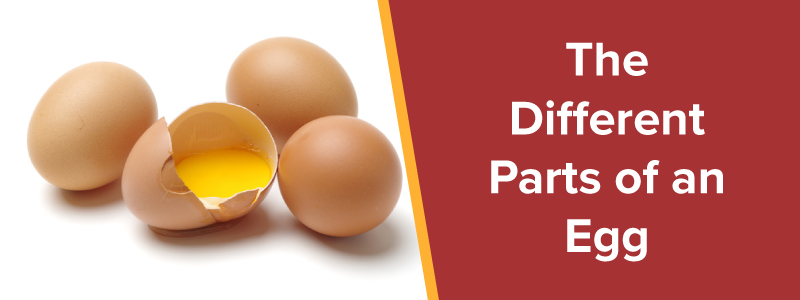
- Overview
- The Shell
- Inner and Outer Membranes
- The Air Cell
- Albumen
- Chalazae
- Vitelline Membrane
- Egg Yolk
There aren’t many ways you can go wrong with an egg.
From the simple and satisfying hardboiled egg to the baked delights of quiches and frittatas, from savory shakshouka to a runny and rich fried-egg topping, their versatility is almost as astounding as their nutrition.
In fact, the health benefits, protein compounds, vitamins, and minerals contained in a single egg are so valuable for your health, eggs are lauded by everyone from experts at Harvard to the U.S. National Library of Medicine and the National Institute of Health — plus many, many more.
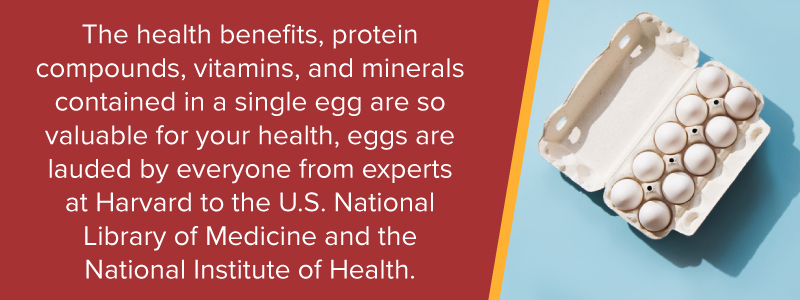
Though advice on egg consumption has fluctuated over the past decades, the science speaks for itself. And that science all comes down to the unique structure and components of an egg — a complex anatomy squeezed inside a small shell that’s made to nourish and fuel your body.
Here’s an in-depth guide to the anatomy of an egg, and how those different parts build one of nature’s most sustaining foods.
The Shell
The shell of the egg is one of the most recognizable and distinct parts of an egg’s entire anatomy. And it’s not difficult to see why. Eggshells’ symmetrical, oval shape, their smooth, seamless texture, and their lightweight, almost fragile feel — all neatly sitting inside a cardboard or styrofoam package — are staples in fridges and pantries worldwide.
While many of us can instinctively identify eggs from these exteriors, we often don’t know the distinguishing features of a shell or their compositional makeup.
The Anatomy of the Egg Shell
Contrary to their smooth and plain appearance, eggshells are surprisingly complex coverings that go beyond a mere bacterial line of defense:
- Calcium Carbonate (CaCO3) Coating: The majority of an eggshell is comprised of tiny crystal calcium carbonate particles. It’s these crystals that give eggshells their exterior makeup — a relatively smooth texture with occasional grains or bumps.
- Semipermeable Pores: Invisible to the naked eye, eggshells contain between 7,000 and 17,000 semipermeable pores that allow air and moisture particles to pass through. This semipermeable membrane also “breathes out” carbon dioxide like we do and takes in beneficial atmospheric gases such as oxygen.
- The Bloom: The bloom acts as a porous shield of protection. It’s imperative to the fertilization of eggs — if allowed to do so — as blooms block harmful bacteria and dust from entering the egg while reducing excess moisture loss.
- The Cuticle: Related to the egg’s bloom, the cuticle is a natural protective coating that is the outermost layer of the entire shell. It seals the passage of gases and bacteria inside and outside and signals the formation of the harder calcium carbonate coating during egg formation.
Both the bloom and cuticle layers of the shell are natural additions to an egg’s anatomy and serve to protect and extend the life of the egg. In nature, both these parts gradually subside on their own as a fertilized egg develops.
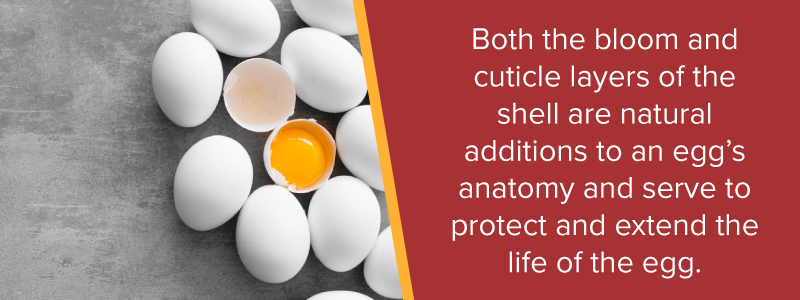
In commercial egg harvesting operations, however, the bloom and cuticle are easily washed off during cleaning and packaging stages. It’s not uncommon for some operations to respray eggs with a mineral oil to replicate the protective properties of the bloom and cuticle, though these sprays are safe and not the least bit harmful to humans.
Egg Shell Sizes and Colors
Savvy grocery shoppers already know eggs come in a range of sizes, weights, and colors. Yet what exactly do these elements tell us about the quality and nutrition of the egg, if anything?
- Shell Size: In the United States, egg cartons are graded and sold based on their weight per dozen. Eggs can be categorized into seven volumes, with jumbo and large eggs the highest commercially sold and most referenced throughout recipes. An egg’s weight also includes the net mass of the entire makeup, including its shell.
- Shell Color: Chicken eggs come in a rainbow of colors, from blues and greens to whites, browns, and even speckled varieties. The most common commercial eggs you find at the store or farmers market are white and brown. Contrary to egg lore, there is virtually no health difference between lighter and darker-shaded eggs. All contain the same ratios of micro and macronutrients, requiring the same storage and preparation. The color of an eggshell is contingent on the breed of the hen that laid it. Hens with white feathers typically lay white eggs and hens with brown feathers lay brown eggs.
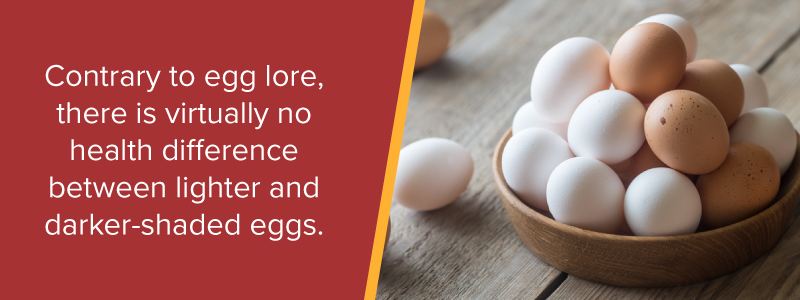
- Shell Textures: Most eggs come with an even and spherical outer coating that’s smooth to the touch. Small bumps and grains can appear across shell surfaces and signal spots of higher calcium deposits and crystal formations.
Inner and Outer Membranes
Tucked just inside an egg’s outer shell are the inner and outer membranes — thin, amino-acid rich layers that serve many protective functions.
Though they may seem like one layer to our eyes after we crack open a fresh egg, these membranes sheath different parts of the egg and complement each other’s shielding and ventilation properties. Between the two, they build a cozy and compressed nest for the more fluid and liquid proteins inside of the egg.
Outer Egg Membranes
The outer membrane is a translucent, film-like gel that nestles immediately next to the eggshell. As a freshly laid egg cools, the inner and outer membranes separate and form respective layers of their own. It’s this cooling process that triggers the development of egg’s much-needed air cells, an egg component all its own that rest at the edge of the outer membrane.
Outer membranes encourage the porous activities of eggs. They operate as a bacterial barrier and air molecule terminal, with oxygen, nitrogen, carbon dioxide, and other gaseous particles coming and going like peak traffic at Grand Central Station.
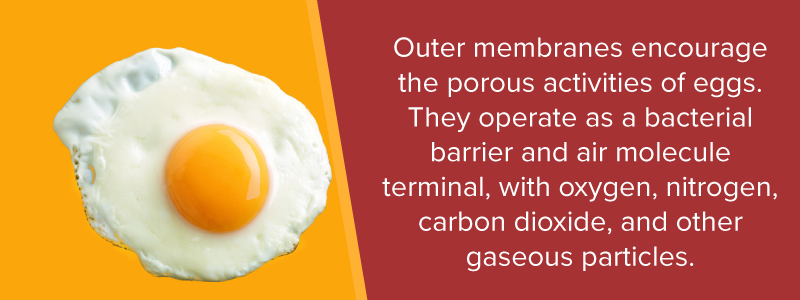
Inner Egg Membranes
Likewise, inner membranes are the second translucent protein barrier tucked right after the outer membrane. While the outer membrane adheres to the eggshell, the inner membrane surrounds the albumen — more colloquially known as the egg white.
The inner membrane gives a one-two punch to the bacterial and gas sorting capabilities of the egg. It is one of the many components of the egg that works in harmony with the proteins and compounds around it to create a secure and nutrient-dense egg filling.
It is also proven to be the strongest of egg’s protective layers, with inner membranes the most effective bacterial blocker among its trio of eggshells and outer membranes. The inner membrane is so durable, in fact, that its unique chemical proteins and fiber makeup is often extracted and put to the test in other bacterial environments, meant to bolster these new environment’s own anti-bacterial properties.
Key Makeup of Inner and Outer Membranes
Both inner and outer membranes are partially made of keratin — the same protein that builds human hair. This fibrous amino acid is a strong and robust variation that is water-insoluble and microscopically dense, transforming these thin inner and outer membranes into the sturdy protective shields they are.
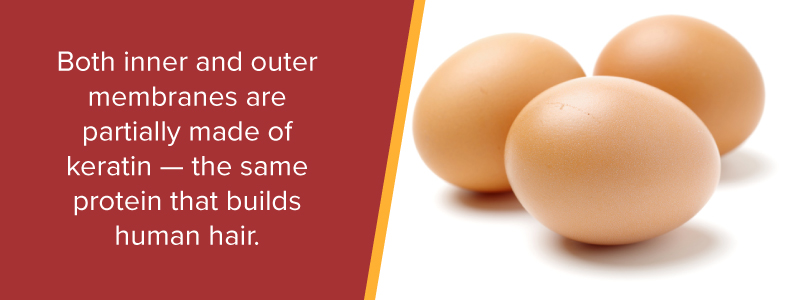
- Membrane Color: Both the inner and outer membranes are clear and translucent. They don’t have a color as much as they have a sheen, a slight pearly gloss that can just be picked up with the naked eye.
- Membrane Shape: Thin and gelatin-like, membranes shape around their adjacent egg components to form their protective layers. Outer members morph to be slightly ovular while inner membranes work to fluidly protect the egg’s next layer, the liquid albumen.
- Membrane Consistency: Inner and outer membranes are made up of keratin and protein fibers that give them their gel-like consistency. The only noted differences in their compositions may stem from chicken feed, with different feed types slightly affecting all parts of the egg.
The Air Cell
You’ve punctured hundreds of air cells across the eggs you’ve scrambled, stir-fried, baked, and boiled in your life — and it’s likely you never even realized it.
These bubbles of air rest snuggly between the inner and outer membrane of an egg and are recognizable only when the insides of an egg remain wholly intact. That’s because they form as an egg ages, with carbon dioxide and moisture exiting through pores and oxygen flowing in to take their place. It’s a recognized rule of thumb that the older an egg, the larger and denser an air pocket will be.
Air cells tend to rest opposite the pointed end of an egg, nestled into the more rotund and spacious bottom curve. This placement also leads to a little-known egg fact: That small crater or concave you see at the bottom of a hard-boiled egg? That’s the direct imprint of the air cell. It’s also why older eggs are slightly easier to peel after being boiled.
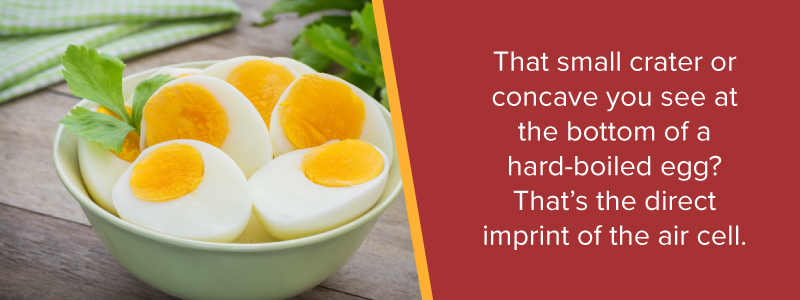
The Formation of Air Cells
Freshly laid eggs are hot, with healthy temperatures hovering around 105°F. However, once collected, the inside of these eggs begin a cooling process that changes their internal composition and triggers development.
The interior of an egg begins to drop in temperature. This results in increased states of gaseous flow as internal components respond by contracting in size. Excess moisture and carbon dioxide get pushed out through membranes and shell pores, while oxygen gets brought in and stored.
The longer an egg is left alone, the more oxygen it will store. Thus, it will contain a larger and more pronounced internal air cell.
Air Cell Anatomy
The anatomy of an egg air cell is simple yet effective. It forms its aptly-named air bubble during the egg’s liquid contractions, the pivotal shrinking period that takes place as the egg naturally cools.
Air cells can grow to be rather spacious in relation to the ratio of the egg. Indeed, you can experiment at home by hard boiling a group of older and newer eggs, then comparing the size of those bottom imprints. Similarly, you can turn some eggs upside down and keep others seated on their wide end to see if the air cells dislodge — a process known as free floating. Free-floating air cells don’t ruin the integrity of the egg, but they do slightly shorten its recommended shelf life.
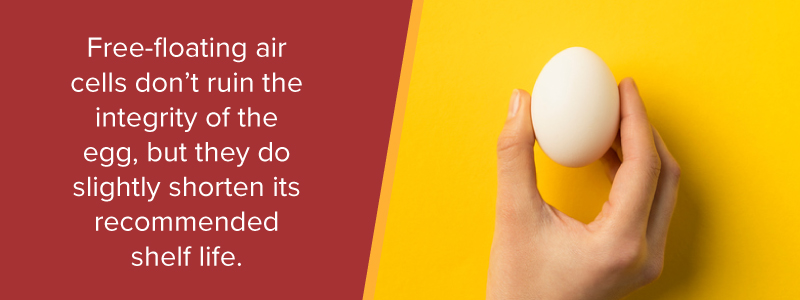
Finally, air cells can occasionally split or rupture on their own, causing two or more smaller bubbles to form near the original sack.
Air Cell Functions
Without its natural cooling down and gas-releasing period, air cells can’t form. And if air cell growth remains stunted, eggs would never bear any chickens, as, without these oxygen pockets, fertilized embryos cannot mature.
Nutritionally, air cells assist in maintaining proper internal conditions for the egg whether fertilized or not. The vibrant chemical interactions that take place between the air cell gases and the rest of the egg’s fluids and proteins rely on oxygen transfers for their stability and quality.
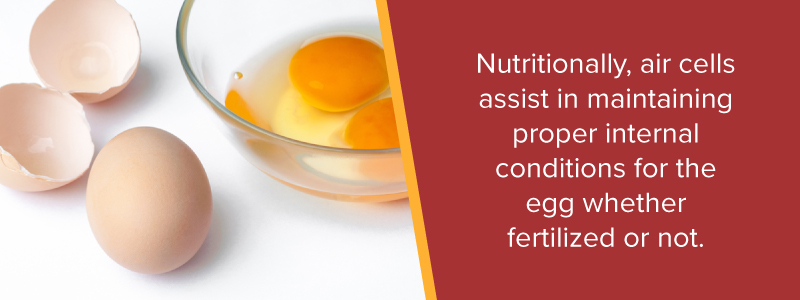
Are There Differences in Air Cells?
Regardless of egg grade, shape, color, or size, it will contain an air cell. These pockets are universal and essential parts of an egg that keep it healthy and whole, with a stable shelf life and all the diverse micro and macro-nutritional benefits eggs provide.
However, you will very much find differences in the size and even gas levels of the air cells themselves. This is both fundamental and expected given their nature. Depending on what age or stage an egg is allowed to mature into, the size and composition of its air cell will be directly influenced.
Albumen
All components of an egg are essential. Yet an egg simply wouldn’t be an egg without the goopy, translucent fluid that makes up over 60 percent of its interior weight, the albumen.
Of course, you will likely recognize this part of an egg by its popular name: egg whites.
When it comes to the basic structure of the egg, there are few bits as familiar — or as full of myths — as albumen egg whites. Let’s break down this well-known egg component.
Albumen’s Identifying Features
Inside and around the shell, there are a few critical elements to albumen or egg whites:
- Inside the Shell. Contained within the shell and membranes, the albumen makes up over half of an egg’s liquid weight. It is a bright and glossy fluid, but, like the air cell, changes over an egg’s lifespan. The more opaque an egg’s albumen, the younger it is. This is because carbon dioxide creates a murkier or filmier appearance to egg whites, inside or once cracked. As an egg matures, carbon dioxide gets released, giving egg whites their clear sheen and making older eggs more translucent.
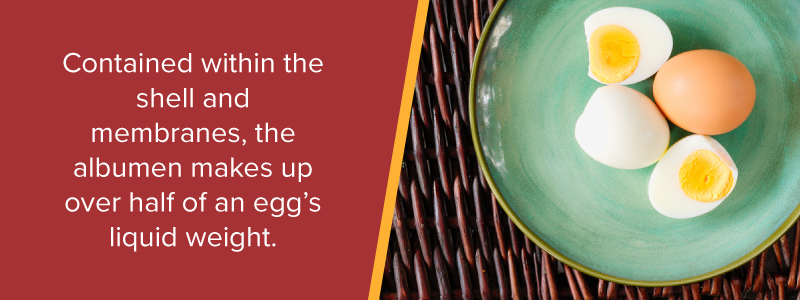
- Outside the Shell. The very name albumen comes from the Latin word albus, which means “white” — a name that makes sense once you crack open an egg and apply heat or whisk. Egg whites that have been successfully separated from yolks behave with different cooking properties and applications. For example, when whisked, egg whites will lighten and puff up to eight times their original volume. This makes them imperative for airy recipes like soufflés, mousses, meringues, sponge cakes, and homemade whipped frostings.
Parts of the Albumen
Egg white fluid is 90 percent water — a surprising consistency considered the remaining 10 percent is almost exclusively protein.
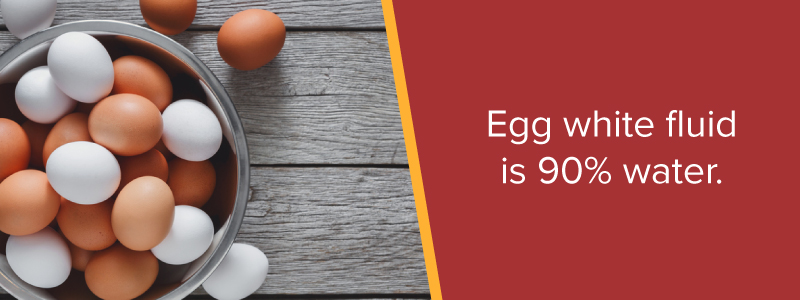
Together, egg white fluid consists of four segmented layers, with each alternating between a thin and thick consistency. This mix of consistencies provides egg whites the robust template that holds over 40 different amino acids — and is precisely what gives egg whites their well-known protein-packed reputation.
- Chalaziferous White. The “inner thick,” or chalaziferous white, is the first and most central layer of the albumen. It rests around an egg’s yolk, helping stabilize the yolk’s movements so it remains in the center of the egg. It is also rather concentrated and capsule-like, engineered to hold the richer and denser yolk and the connected chalazae.
- Inner Thin White. This layer of the albumen comes after the chalaziferous white as the next yolk-protecting capsule. It is much larger and more pronounced than its inner thick neighbor, pooling more liquid and containing a healthy amount of those 40-plus egg white proteins.
- Outer Thick White. Abutting the inner thin white, the outer thick white provides further egg white fluid and texture to the albumen fluids.
- Outer Thin White. The final and furthest layer from the central yolk, the thin outer white holds further protein-based nutrients and compounds that would aid in overall embryo growth if the egg was fertilized.
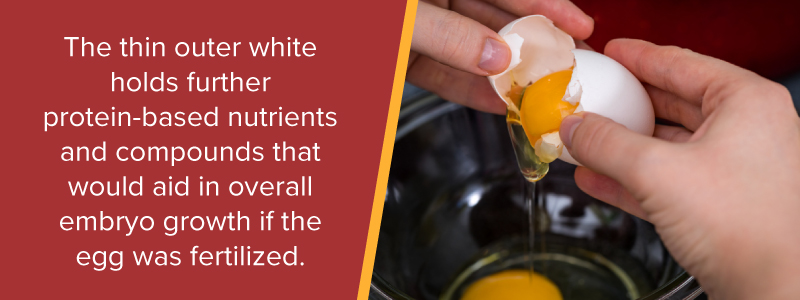
All layers of egg whites are susceptible to thinning as the egg ages. This is why fresh fried eggs tend to hold their shape better when first cracked in a pan while older eggs spread out.
Albumen Functions
The function of egg whites is twofold. Yet in today’s world — with what can seem like endless contradictory health and nutrition advice — the features and benefits of egg whites often get caught up in swirling and even heated misinformation.
First and foremost, all layers of the albumen are meant to protect the yolk. Since the yolk is the literal and figurative center of a healthy egg, the various consistencies and textures of alternating albumen fluid fundamentally serve to shield the yolk from movement and damage.
Second and equally critical, egg whites house over half of the entire egg’s protein count. Though protein compounds make up only about 10 percent of albumen fluid, they make what’s there count.
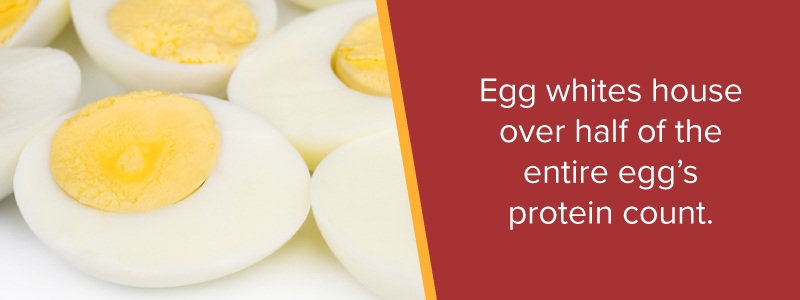
Protein is one of three major nutrition categories for humans, along with fats and carbohydrates — which egg whites alone have little-to-no traces of. It’s also what’s made isolated egg whites the much-discussed protein fad of the past decade, with more on its exact nutritional makeup below.
Albumen Nutrition
The average egg white, sourced from one large, Grade A egg, will contain the following micro and macronutrients:
- Calories: 17
- Calories From Fat: Zero grams — egg whites are naturally fat-free.
- Carbohydrates: Less than one gram.
- Protein: Four grams, out of a large egg’s roughly 5.5-gram total.
- Vitamins and Minerals: Egg whites contain micrograms of calcium, folate, choline, selenium, magnesium, phosphorus, and potassium.
Many of these vitamins and minerals are lacking in the standard American diet. Folate and choline, in particular, are essential for cell growth, DNA replication, and hormone production, while calcium and magnesium build and activate hundreds of distinct enzymes in our bodies to regulate blood sugar, blood pressure, nerves, muscles, and bone development.
Regardless of hen type or egg color, these compounds are found in all egg whites.
Chalazae
You can learn a lot about the quality of your egg based on its chalazae. Chalazae are the long, stringy, fibrous little squiggles that run through and around an egg’s yolk.
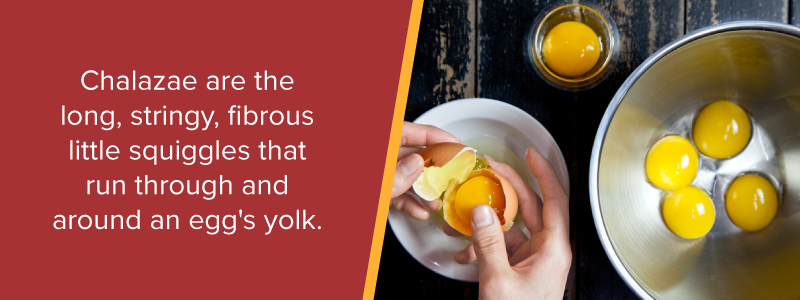
Chalazae are another of the rather unknown yet important pieces in the anatomy of an egg. That’s because few egg features enhance and preserve the structure and safety of the yolk quite like the chalazae.
Identifying the Chalazae
At first glance, it’s easy to mistake these white, string-like ends surrounding the yolk as part of the egg whites. It’s also easy for some to mistake chalazae as abnormalities or growths in a spoiled egg, as their look and texture don’t quite match nearby fluid.
You can identify the chalazae using the following visual cues:
- Squiggly appearance. A fresh egg will have chalazae that look like crumpled-up, white string, or a trail of squiggly, half-dried glue. In most cases, it will be strung around or attached directly to an egg yolk.
- Two distinct ends. Chalazae will appear on two ends of the yolk. These ends will be directly opposite of the other, almost as if you threaded the chalaza on a string, poked it in one end of the yoke, then threaded it out the other.
- Milky or frothy coloration. Chalazae will be slightly darker and milkier in color than their surrounding fluid. They stand out against the bright gold of egg yolk and the transparent albumen fluid and can be slightly denser and gelatinous in texture as well.
- Positioned on the edge of the yolk. Fresh or a few weeks old, chalazae should be poised right on the edge of the yolk. Some even refer to them jokingly, though aptly, as a yolk’s tail.
Chalazae Functions
Chalazae are entirely edible and harmless. Though they initially might offset the aesthetic, clean look you were going for with your just-cracked egg, they actually signal you have a fresh, undamaged, and structurally intact egg on hand.
Chalazae work alongside albumen layers to keep the egg yolk intact. They operate like yolk scaffolding, supporting and balancing the yolk’s movements so that delicious, bright center stays, well, center.
This is especially important for fertilized eggs. As chicken or other poultry embryos grow, internal components of an egg are delicately arranged just so to connect to, fortify, and feed that budding life easily.
Chalazae keep that connection in place, preventing off-set yolks. They are the ropes that literally anchor a delicate yolk’s outer casing to the eggshell and membranes, made up of strong and similarly fibrous proteins.
Changes to the Chalazae
Chalazae naturally change over time, both in color and size. As such, they’re a great way to determine the freshness of your eggs.
Fresh eggs will have the most string-like and visible chalazae. They will be long and textured, with the newest eggs still containing a chalazae rope on both two sides of its yolk. You will easily see them as soon as you crack your egg.
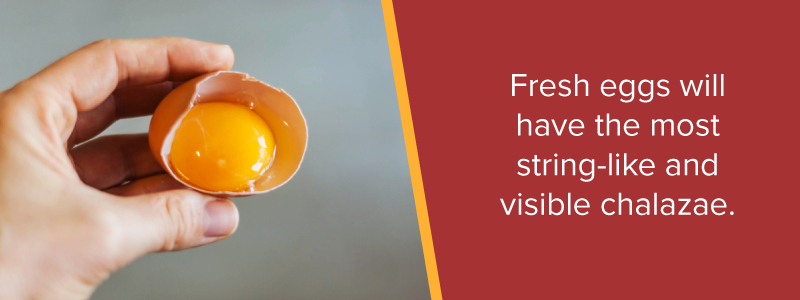
As eggs mature, their chalazae will innately start to fade. You may find chalazae that have clumped together or straightened slightly, as well as threads that remain intact but are more translucent, beginning to blend into egg whites.
Vitelline Membrane
As the anatomy of the egg gets closer to the yolk, it develops one more protective sheet — the vitelline membrane.
If you’ve ever attempted to cook the perfect, “snotless” sunnyside-up egg or flip a masterful fried-egg feast, you’ve encountered — and perhaps battled — the vitelline membrane.
It’s the final layer directly casing an egg yolk, with a pearly and polished sheen. Like other membranes, the vitelline layer stands to protect the yolk from cracking and seeping fluid everywhere, whether inside the shell or out.
Vitelline Membrane’s Makeup
The vitelline membrane is made up of two layers, so small they are measured in micrometers and hardly perceivable to the human eye.
Vitelline membrane’s inner layer is thicker, coating the surface of the yolk in parallel strings of 1–3.5 micrometer-thick casings. The outer layer of the vitelline is the thinner and more delicate of the two, averaging measurements around 0.3–0.5 micrometer for its individual sublayer.
Its the strength and viscosity that these two layers that makes or breaks a vitelline membrane. The healthiest of these coatings will appear as their own distinct layer. If poked or prodded, fresh eggs with strong vitelline membranes will ebb back to their original position without punctures or tears.
The rule of thumb follows that the older an egg is, the weaker its vitelline membrane will be. Like the chalazae and a few other egg components described here, this clear casing gradually becomes more fragile as egg hormones develop or eggs remain dormant.
Vitelline Membranes and Protein Anatomy
Vitelline membranes are made up of a particular type of protein called glycoproteins. While other amino acids and protein types exist within the inner and outer layers, glycoproteins are part of the reason the vitelline membrane give the egg yolk its shine and opulence.
Glycoproteins come in microscopic shelved layers, meaning they stack on atop the other. Interestingly, this protein type also commonly links with carbohydrate molecules to formed strengthened side chains.
Glycoproteins are found in most organisms. You yourself contain a significant amount glycoproteins, comprising features like your hair, skin, tendons, and ligaments.
Vitelline Membrane Function
The vitelline membrane does the job of a few coatings.
It keeps the egg’s central yolk separate from the albumen, which is imperative for a number of reasons. If an egg’s yolk were to crack, seep into, and mix with egg whites — particularly inside the shell — the integrity of the fluids and the purpose of the egg’s design are ruined. Whether fertilized or not, a cracked internal vitelline membrane will destroy the egg.
The vitelline membrane is also responsible for protein binding during the fertilization process. Without the signals and receptors held within its inner and outer layers, an egg would not be able to initiate the development of an embryo. It then acts as a gatekeeper for further hormones and substances to either pass into the yolk or remain blocked.
Mottled Eggs and the Vitelline Membrane
The term “mottled egg” refers to the occasional white spots or blotches you see over an egg’s yolk. They’re neither uncommon nor harmful, with over 50 percent of commercial eggs containing some degree of patchy mottling.
Contrary to how it sounds, mottled eggs are still perfectly good eggs you can cook and bake. These white spots do not affect the quality or nutrition of egg yolk, and should only be a source of concern if the yolk itself appears discolored, with green or gray shading rather than vibrant golds and oranges.
Mottling occurs as the yolk’s vitelline membrane ages, and its strength and viscosity subsequently reduce. The fresher an egg, the more likely it won’t contain any yolk mottling.
Egg Yolk
Perhaps most beloved of all parts of the egg is the egg yolk.
And it’s no surprise! That rich, runny, savory center is not only easy on the taste buds — it’s the nutritional heart of the entire egg, one as delicious as it is imperative to reap the full health benefits of eating eggs.
Egg Yolk Misunderstandings
The egg yolk has been the source of much contention over the years. Yet the most recent yolk scientific and nutritionist research has come a long way in unscrambling these competing health claims, understanding and identifying more nuanced and balanced reasons as to why yolks received such a bad reputation.
Its vilification began in the late 1970s and early 1980s when researchers started taking a serious look at heart disease rates and other related complications rising in the U.S. Many of these researchers honed in on cholesterol and fat, a well-intentioned but now well-understood oversimplification of the balance between health, genetics, and diet.
- Egg Yolks and Cholesterol: Everone knows egg yolks contain cholesterol — roughly 180-200 milligrams per yolk. Yet not everyone knows the difference between dietary cholesterol, like what’s contained in eggs, and blood cholesterol, what’s naturally produced by your liver. Contrary to lingering hype, there is little research linking dietary cholesterol with heart disease and related health issues. Rather, heart disease is much more associated with high consumption of trans and saturated fats in things like processed foods and vegetable oils, alongside excessive amounts of sugar in a daily diet. In other words, the other items found on breakfasts tables — such as bacon, sausage, butter, and fruit juice — are far more likely to contribute to heart disease and harmful cholesterol levels than eggs.
- Egg Yolks and Fat: Again, contrary to the hype, egg yolks are not only low in problematic trans and saturated fats but contain good fats essential for our health, like omega-3s. The average large egg contains just 1.5 grams of saturated fat while rounding out with fat-soluble vitamins like B6 and B12 and other essential fatty acids.
Role of the Egg Yolk
The role of the egg yolk is simple — to provide nutrients for a developing poultry embryo. Like seeds, they are self-sufficient suppliers of a tremendous amount of vitamins, minerals, and healthy fats — everything needed for the optimal development of new life or the sustenance of those who cook and consume them.
Nonfertilized egg yolks still contain all these nutritional components. In fact, over half of the nutritional boosts of eggs are stored in the yolk, meaning to soak in an egg’s full benefits, you shouldn’t skip out on that golden center.
Variations in Egg Yolks
Egg yolk colors vary based on two factors: the breed and diet of a hen. The most common yolk variations include:
- Yellow and Orange Yolk: Hens fed a diet rich in orange and yellow feed, such as corn, alfalfa meal, and unprocessed wheat or barley will produce darker and oranger yolks. Other food heavy in the pigmented protein xanthophylls — such as certain insects — will also result in yellow or orange yolks.
- White Yolk: Colorless or white yolks are common in hens fed diets heavy in white cornmeal or processed barley.
- Double Yolks: Some eggs may contain two yolks, more prominent in the eggs of younger hens whose reproductive cycles have not solidified yet. Yet some hens will produce double-yolked eggs their entire reproductive lives.
Egg Yolk Nutrition
The vitamins and minerals within egg yolks are some of the most varied and dynamic in a balanced diet. What’s more, your body needs many of the fat-soluble pairings found only within the yolk to fully absorb the complete nutrition of the egg.
Without egg yolks, you would not receive the following nutritional doses of:
- Vitamins A, D, and E: Necessary for cell, muscle, bone, organ, and immune system health and functionality.
- Vitamins B6 and B12: Aid in brain function, hormone regulation, and nerve and blood-cell health.
- Iron: Allows the blood to carry and circulate healthy oxygen levels.
- Calcium: Critical for bone and muscle health.
- Phosphorus: Involved in the body’s ability to metabolize energy, as well as works with calcium to fortify bones and muscles.
- Lutein and Zeaxanthin: Promote eye health and contain free-radical fighting antioxidants.
- Choline: Enhances brain, liver, and nerve functions as well as maintains healthy metabolic and energy levels.
- Protein: One large egg yolk contains six to seven grams of protein, a little less than half the total protein of an egg.
Sauder Eggs: A Complete System for Complete Fuel
A healthy consumer is an informed consumer. This all starts with understanding the basic components of what you choose to put on your plate, what it’s made from, and where it’s sourced — all while sticking to a comfortable and sustainable budget.
With eggs, you get a complete powerhouse built to fuel. Each part — from the protective shell to the porous membranes, the stabilizing chalazae to the nutrient-dense and vital yolk — is designed to nurture and support life.
With their unique combo of essential vitamins, minerals, fatty acids, and amino acids — of which eggs score amongst the most efficiently digestible of all proteins — it’s hard to ignore the health benefits of eggs.
Subscribe to Sauder’s Egg Club, our newsletter for all-things eggs. This means leading insights, information, and foodie resources, as well as egg-celent recipes and insider egg product offerings, straight from our family to yours.
